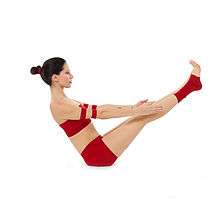Navasana

Naukasana ("Boat Pose") is a seated yoga asana. Variations include Paripurna Navasana (Sanskrit: परिपूर्णनावासन; IAST: paripūrṇanāvāsana "Full Boat Pose"),[1] Ardha Navāsana (Sanskrit: अर्धनावासन "Half Boat Pose"),[2] and ekapadanavasana ("one legged boat pose").
Etymology
The name comes from the Sanskrit words nava meaning "boat" and asana (आसन) meaning "posture" or "seat".[3][4] In its literal translation, "Boat Pose", the body could be imagined to resemble a boat, entirely balanced on the buttocks.
Description
The body comes into a V-shape, balancing entirely on the buttocks. In different variations and traditions, the arms legs and torso may take different positions. In Paripurna Navasana, the legs and back are lifted high and arms extend forward and parallel to the ground. In Arda Navasana, hands interlace behind the neck and both back and shoulders are closer to the ground.
To come into the pose, begin seated on the floor. Bend your knees, bringing the soles of the feet to the ground, and bring the palms to the back of the thighs. Begin to lean back as your shift your weight off of your feet, eventually lifting the soles of the feet off the earth all together. Balance on your seat bones, but not so far back that you're balancing on your tailbone. Lengthen the spine to broaden and lift the chest[5].
Benefits
The asana strengthens the abdominal muscles, the legs and the lower back. Paripurna Navasana is said to relieve stress, improve digestion and aid the lower abdominal organs: kidney, intestines, and prostate for men. It can also stimulate the thyroid.It helps to improve concentration and enervates numbness in mind. It builds willpower, determination and self control.[6] Ardha Navasana works on the upper abdominal organs: pancreas, gall bladder, spleen and liver.[7]
See also
References
- ↑ "Yoga Journal - Full Boat Pose". Retrieved 2011-04-09.
- ↑ "Ardha Navasana (Half Boat Pose)". Retrieved 2011-04-09.
- ↑ Active Interest Media, Inc. (August 1996). Yoga Journal. Active Interest Media, Inc. p. 51. ISSN 0191-0965. Retrieved 25 June 2011.
- ↑ Sinha, S.C. (1 June 1996). Dictionary of Philosophy. Anmol Publications PVT. LTD. p. 18. ISBN 978-81-7041-293-9. Retrieved 9 April 2011.
- ↑ https://www.verywell.com/boat-pose-navasana-3567061
- ↑ Mitchell, Carol (19 June 2003). Yoga on the ball: enhance your yoga practice using the exercise ball. Inner Traditions / Bear & Co. p. 80. ISBN 978-0-89281-999-7. Retrieved 25 June 2011.
- ↑ Hewitt, James (1978). The complete yoga book: yoga of breathing, yoga of posture, and yoga of meditation. Schocken Books. Retrieved 9 April 2011.
Further reading
- Iyengar, B. K. S. (1 October 2005). Illustrated Light On Yoga. HarperCollins. ISBN 978-81-7223-606-9. Retrieved 9 April 2011.
- Saraswati, Swami Satyananda (1 August 2003). Asana Pranayama Mudra Bandha. Nesma Books India. ISBN 978-81-86336-14-4. Retrieved 9 April 2011.
- Saraswati, Swami Satyananda (January 2004). A Systematic Course in the Ancient Tantric Techniques of Yoga and Kriya. Nesma Books India. ISBN 978-81-85787-08-4. Retrieved 9 April 2011.